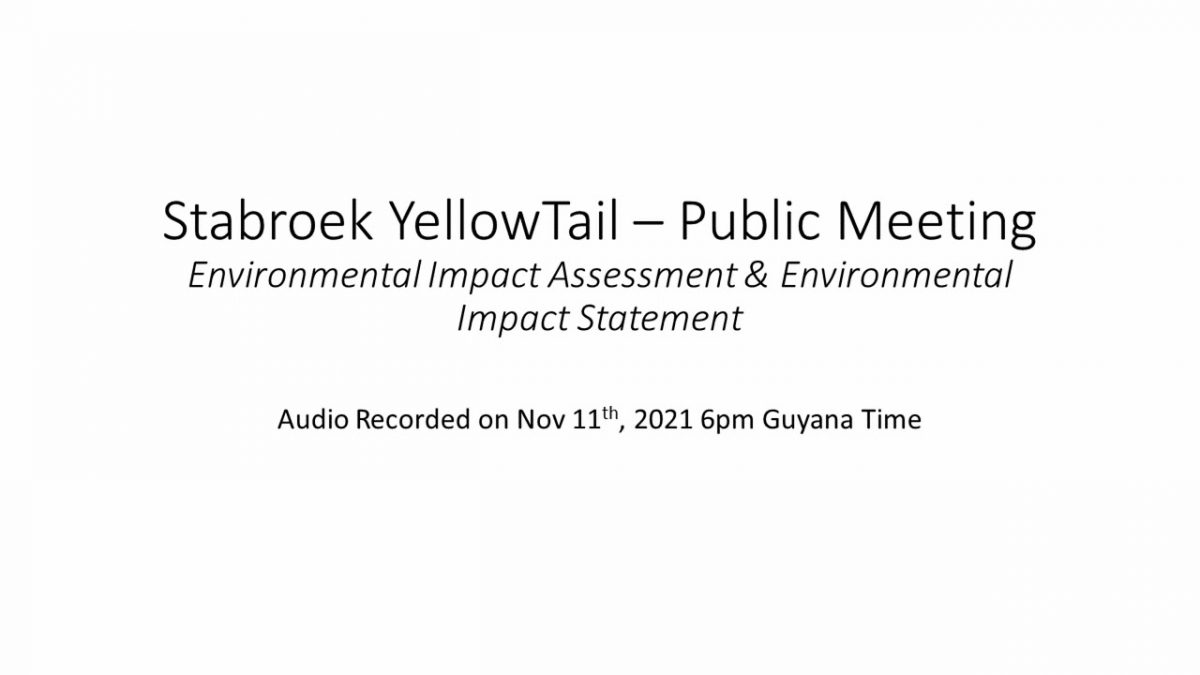
Guyana subscribes to the United Nations Declaration on the Rights of Indigenous Peoples (UNDRIP 2007) which recommends Free, Prior and Informed Consent (FPIC) in relation to Indigenous Peoples. Please explain how you have complied with FPIC recommendations in relation to the Indigenous communities in Regions 1, 2, and 3?
The EIA should say which standards are obligatory in the industry and which best practices are being followed. Where are these obligatory standards and best practices documented? Where is the logbook of each best practice? What are the monitoring and reporting procedures in respect of each Standard? Where are the reports from monitoring of Liza-1 wells? Name the independent auditors that are verifying which aspects of your operation(s). Where are the audit reports published? Please share the pre-treatment and monitoring of pollutants and hazardous elements prior to discharge in accordance with permit requirements, international conventions, standards and best oil & gas industry practice.
Has the EIA quantified emissions including Yellowtail exploration, drilling, transportation, flaring, oil lifts, oil barrel discharges and modelled climate impacts based on emissions of CO2 and methane and its impact in pushing the global warming level above 1.5 C? Guyana and its low-lying coastline has been cited as one of 10 countries worldwide which could be under water from sea incursion by 2030 based on the IPCC 2021 report and according to current global projections of rise in global warming of 1.7 to 2 % Celsius. Have you, therefore, specifically addressed the cumulative effects and impacts of ExxonMobil oil drilling contributing to Guyana’s sea warming? Have you specifically addressed the cumulative risks and impacts of ExxonMobil’s fossil fuels extraction – including flaring etc. which are in contravention of the United Nations Framework Convention on Climate Change (UNFCC) Climate Agreement ratified by Guyana and targets set and agreed globally?
How have you taken into account the closely interrelated impacts of the ExxonMobil-related shore-based service hazardous waste facilities (such as Schlumberger radioactive waste facility at Houston EBD) and included these impacts on the general health and well-being of humans?
There is no mention of a formal monitoring programme, operated by XOM or by a contractor(s) on behalf of XOM, covering all aspects of the oil field development/operation/ decommissioning/safe closure. Section 11(4)(a) of the EP Act specifies areas that should at least be covered in such a monitoring exercise. Is EEPGL currently undertaking this monitoring? Where in the EIA do you provide reference to the records and findings of such monitoring? Are these records in the public domain? What is the evidence that you have transmitted those records?
The Ministry of Natural Resources has been asked to provide information on the chemical composition of the oil that is being brought up and the flow process for production. This industrial process including the volumes of oil recovered, chemical composition and volumes of waste discharged into the air and water, and those transported to land, must be known and stated in the EIA before a proper assessment of impacts and risks can be done.
The EIA says that an oil spill has a high intensity of impact, very low probability. How do both intensities of impact and probability of occurrence change over time, from the time you open a deep well to the decommissioning. Also, if a spill does occur and you clean up, where will you dump the toxic waste?
The purpose of an EIA is to gather information to allow a comprehensive risk assessment of the Yellowtail development. A corporate risk assessment should cover exploration; the production of oil and of water and of associated gas; the FPSO and its activities; the tankers that are coming in to load from the FPSO; all the support vessels; the shore bases; the contractors. What are the different kinds of risks? How did you determine the probability of each risk? For each risk, where is your assessment of the range of intensities of negative impacts, and the probabilities which of course change over time?
Is there insurance for Liza 1 and 2 wells? Which company issued the insurance, what is the third-party coverage, and where is the proof of the insurance? There is also no formal guarantee between ExxonMobil and the Guyana Government that it would cover in full, the shortfall of costs associated with an unmitigated spill which are not covered by its subsidiary – the shell company, Esso Exploration and Production Guyana Limited (EEPGL). Does the ERM think that is acceptable?
Whose responsibility will it be to pay compensation to Caribbean countries for damage to their economies – tourism, shipping, and fishing sectors in the event of a well blowout? Will Esso or the Guyanese people be responsible?
VP Jagdeo is reported to be asking Exxon to deposit US$2 billion for insurance. The Macondo 2010 spill cleanup cost was US$ 60 billion+; does the ERM consider US$2B to be adequate?
The Yellowtail proposal indicates flow lines, umbilicals, abandoned equipment, mooring lines, anchor piles, subsea equipment – will all be abandoned on Guyana’s seashore. This is contrary to best practices in the oil industry. Which best practice standards have you applied? Which industry or government standard(s) are you using? What is the difference in risk between following international best practice and leaving all this toxic junk on the seafloor?
The EIA document says that the study must be produced by an independent body. Can this EIA qualify as independent? And can the EPA be considered as acting independently of the Government Administration that supervises it directly from the Office of the President (OP) when it comes to assessing and approving this EIA? Why is it that ERM has been the consultancy firm with the lion’s share of EPA-OP awarded consultancies?
Nowhere does the EIA completely identify the chemical composition and volumes of waste products that will be discharged. How did you manage to put numbers against the risks when the basic numbers for volumes of pollutants released into the water, air, and sent to shore over time, per day, per year, per barrel of oil, per 25 years, are missing from the analysis? When will you produce the information and conduct an actual impact assessment?
The document says that the final designs for production and operation are incomplete. What substantive difference would there be between the assumptions used to prepare this EIA and the final designs? These need to be explained in detail, as the EIA ought to be conducted when the project designs are known.
The analysis fails to adequately address shore-based operations to enable offshore production and processing of waste sent to shore. How exactly does the current capacity for shore-based support and disposal of toxic waste compare with the exact demands expected for the life of Yellowtail? At what point will this exceed all existing facilities, and by how much?
The annex of the EIA report includes a fisheries study; it has no comprehensive mapping of the fish nurseries, in Guyana or in neighbouring countries that might be feeding our fishery sector. There are no indications whatsoever in any baseline study done, including the marine baseline study done, of what the migratory patterns are of commercial or non-commercial fish compared in that whole zone of mud that extends all the way from Northern Brazil. There is no description, material or financial, of the fisheries value chain. There is no quantification of the economic value, direct economic financial value, both in terms of its contribution to the economy and to the subsistence economy. There is no quantification of the socio-economic value of that industry in terms of livelihood, family dependency or the importance of fish consumption to the people of Guyana. There is no information on any chemical testing of fish. No baseline data had ever been collected before extensive seismic surveys commenced offshore of Guyana. In fact there is no baseline data whatsoever for the most elementary thing that one could possibly be socially responsible about, which is fishing. This EIA speaks about 4-D surveys, which means that this stuff will be going on over time. So we’re in a situation where our regulatory authority under the previous administration permitted this to occur and our regulatory authority under the present administration is continuing with this. How can an EIA be submitted which has failed to treat with fisheries, with nurseries, with migratory patterns, with catch per unit effort, how that has changed over time – comprehensively (not a study of Region 6 one guy and one from region 2 and region 4 etc.)? We want to know from ERM and from Exxon Mobil and the EPA what will be done to address the fisheries situation right now.
Exxon has indicated that its preferred choice and intention is to dump produced water from the Yellowtail Project into the ocean because it’s cheaper to dump produced water than to re-inject it. Produced water is regarded as a high-volume toxic waste. The capacity of the FPSO is 1M barrels of oil. Your estimate is that you will be generating 100,000 barrels of produced water a day. So in 10 days you would have filled up the tanks of the FPSO with produced water. The people of Guyana are more interested in how the produced water with all its residual toxins would harm our marine resources, fishing grounds, coastline, and our overall environmental wellness. Is the EPA willing to hold Exxon to reinjecting the produced water versus its preference for easier work in just releasing the water into our marine habitat? This is in addition to produced water released by the Liza One, Liza Two and Payara Projects. How does the EPA intend to monitor all of this? Does the EPA know what technologies will be used by ExxonMobil in this regard? If XOM is now saying that it is not going to reinject the produced water, then that appears to contradict clause 12 of the Production Sharing Agreement (PSA) 2016. And if XOM can unilaterally change the PSA, you would agree that the government also change its mind on specific items in the PSA?
What is the amount of produced water which will be released into the marine environment from the Yellowtail on a weekly, monthly, and annual basis and what will be the monthly average and daily maximum concentrations (mg/L) of total oil destined for ocean disposal?
How are you going to treat the produced water from Yellowtail wells? To what standards? Name the standards that you will be using? How and where you will be treating your produced “waste-water”? Which components of the produced water will be treated?
The assessment treats the environment as static, as if conditions 15-20 years from now will be identical to today. Guyana will be experiencing higher and rougher seas, heavy land-based precipitation and flooding, different storm activities offshore etc. Where is the climate modeling predictions and changing assessment of risks as conditions offshore and on land change over time 15 years from now, 20 years, 25 years when you are decommissioning? There is no risk assessment if time and changing conditions are not considered.
